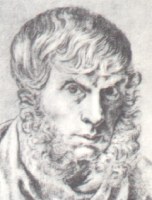
German painter, born in Greifswald, close to the Baltic Sea, and now famous for, principally, landscapes and seascapes charged with religious symbolism.
Friedrich studied at the Copenhagen Academy under Abildgaard and others.
From 1798 on, he lived in Dresden, but returned repeatedly to the North coast and travelled also in the mountains of Germany and Bohemia.
His early work was mostly in pen and wash on paper, but already used truthfully observed natural imagery as sermons on life and death.
From 1807 on, he worked mainly in oils and began to find eminent purchasers for his work as well as commissions. The first of these, for The Cross in the Mountains (1807-1808), was for an altarpiece showing a tall wooden crucifix on a rocky mountain-top among fir trees, with Christ’s figure facing into the picture towards the setting sun.
With its elaborate carved frame, to Friedrich’s design, the whole work is a complex statement about religious faith and hope, but it was gravely criticized at the lime by those who demanded an established religious subject.
For Friedrich nature was a church, every part ol it rich in transcendental significance. The artist’s task was to use this resource, starting from detailed drawings as his stock ol models. Human beings and their activities also served his symbolism: sailing ships in harbor, real or imagined Gothic buildings in the mountains, a tiny ship crushed by great shifting slabs of ice (Arctic Shipwreck, 1824), or isolated figures gazing at the sea, as in The Monk by the Sea (1809) of which has friend the poet Heinrich von Kleist wrote ‘Since in its uniformity and limitlessness it has no other foreground than the frame, looking at it makes you feel your eyelids have teen cut off.’
Friedrich’s work, often on quite large canvases, was highly regarded in his earlier years. Famous writers, including Goethe, were his friends and acquaintances. The King of Prussia and the Crown Prince, and later Nicholas I of Russia bought his work; he was visited by important artists; he was elected to membership of the Dresden Academy, which brought a stipend; he was close to, and influenced, Runge and younger artists such as Dahl and Kersting. But in 1825 he suffered a serious illness. This was followed by an incapacitating stroke in 1835, and he returned to working on paper.
In any case the advance of Romanticism had brought a new, more vaguely enthusiastic, note to landscape painting and had made fashionable pictures relying on nostalgia for a medieval world, to Friedrich a denial of true spirituality in art. His coolly passionate paintings were no longer in demand.
During the decades that followed his death he and his work were largely forgotten, until it was studied again, and honored, from the 1890s on, in time to attract the attention of Munch, Hodler, Nolde, Klee and other key figures in early modernism.
